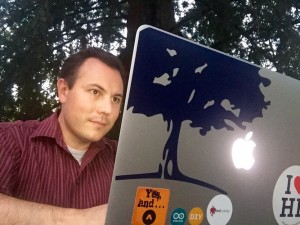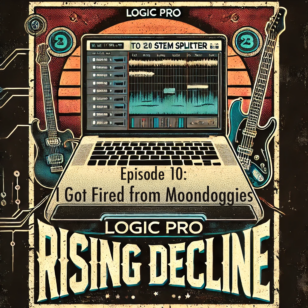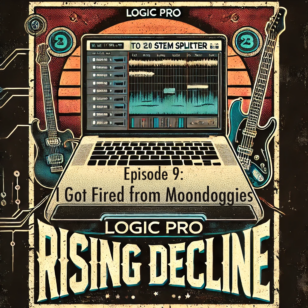As I reflect on my first year as Director of Technology at Hillbrook, the first thing that jumps out to me is this sentence. First year!? It’s only been one year, but it feels like many more (in a good way). My first goal this year was to listen and learn what Hillbrook does with technology to better understand the community. I’m glad I didn’t jump right in and make dozens of changes. Some of my initial ideas would have not fit well culturally, or weren’t actual needs of the teachers and students. So I listened, and I’m glad I did.
The first thing I focused on was to identify things that aren’t working. Right away I heard complaints around inconsistent wifi. As I entered my new role, our former IT specialist left his role. This left me with a huge gap in my team for monitoring, maintaining, and learning the back end (that’s what IT folks call stuff that isn’t face-to-face). After many hours of finding switch closets and access points, I have a good understanding of how the campus was connected. I conferred with Christopher Sokolov from SFDS, and he suggested hiring Novani LLC as a consultant.
 From August 2014 through April 2015, Aaron from Novani worked with us on two major projects–a discovery process and a new server. In the discovery project, every piece of hardware was identified, added to a spreadsheet, and updated. We discovered that all of our switches (the thing that makes one fiber optic connection transform into 30 ethernet ports) needed firmware updates. This fixed most of the wifi inconsistencies. Additionally, we replaced two switches that were slow and old. Those two adjectives are bad in technology. The other significant project was purchasing and installing a new server. We had several old and out-of-date servers. These impaired file sharing, since the shared network drives didn’t always show up online. This also meant that everything on our network was a bit slower and inconsistent. A new server led to faster download speeds, more consistent wifi connectivity, and consistently online shared drives. This huge project, paired with constant tinkering with wifi access points, brought a more consistent internet connection experience.
From August 2014 through April 2015, Aaron from Novani worked with us on two major projects–a discovery process and a new server. In the discovery project, every piece of hardware was identified, added to a spreadsheet, and updated. We discovered that all of our switches (the thing that makes one fiber optic connection transform into 30 ethernet ports) needed firmware updates. This fixed most of the wifi inconsistencies. Additionally, we replaced two switches that were slow and old. Those two adjectives are bad in technology. The other significant project was purchasing and installing a new server. We had several old and out-of-date servers. These impaired file sharing, since the shared network drives didn’t always show up online. This also meant that everything on our network was a bit slower and inconsistent. A new server led to faster download speeds, more consistent wifi connectivity, and consistently online shared drives. This huge project, paired with constant tinkering with wifi access points, brought a more consistent internet connection experience.
Another big issue I noticed was problems accessing Google stuff from parents. I worked with parents one-on-one to get them access to what they needed, mostly Google Drive folders and the HSPC (Hillbrook School Parent Council) Google Site. At the suggestion of HSPC leadership, we decided to move all the information and documents from the Google Site to a shared Google Drive folder (with many child folders inside). This way, we only needed to support parents accessing Google Drive. Most of the problems with access with the fact that parents were already logged in to personal Google accounts and most of the documents and sites required a hillbrook.org Google account. It’s a simple solution, but not terribly obvious if one is on a mobile phone and can’t easily see which Google account is active. To address this issue, HSPC leadership will share appropriate folders in Google Drive with personal Google accounts when requested.
Like payroll, everyone notices when something tech related doesn’t work. Much of my energy this past year involved keeping the internets working. And, like payroll, we didn’t get a huge congratulations when the wifi worked. The lack of response means that the technology is invisible–it just works. Let’s focus on things that worked well this year.
At the beginning of the year, we hosted several tech coffees for parents to learn about tech integration at Hillbrook, as well as ask questions. I was able to introduce myself, and share my vision for how technology can transform student learning. Similarly, our initial digital citizenship training was successful. iPad fundamentals, and digital citizenship fundamentals, are well understood by students. As we move forward, we will be looking closely at how we might deepen the understanding of being a responsible citizen, online and off.
We used two systems in our department to manage support and projects–Trello and MyTechDesk. Both allowed us to provide timely support, and manage tasks as a team.
Another goal was to learn what projects teachers were doing, and help them infuse technology meaningfully. I started a spreadsheet to document ed tech projects at Hillbrook, but did not have the time to keep up with it. Moving forward, I plan to create a shared Google Doc with each teacher to document projects, as well as track support and growth.
My second goal this year was to develop systems to equip teachers to drive meaningful tech integration. Teachers were introduced to the SAMR model two years ago. On September 24, our team led PD around SAMR through a tool-based challenge. Faculty chose one tool, and explored how that tool could be integrated through Substitution, Augmentation, Modification, or Redefinition. This was one of the few tool-based trainings we led. I believe it was successful because faculty had choice on which app to learn, and they worked collaboratively to explore the SAMR model.
I created a private Google+ Community for Hillbrook employees. Introduced on January 14 during a faculty meeting on Showing Your Work, this community is a way for teachers to share ideas asynchronously. From videos of baby goats in pajamas to research on the Maker’s movement, this Google+ Community is a way to collaborate, connect, discuss, and share resources.
The middle school history department piloted Google Classroom. This system is so new that it was challenging to consistently use. To their credit, the history department began using Classroom before it even had an iPad app! Mostly abandoned due to lack of co-teaching support, Google Classroom is a great example of how teachers take risks in technology, and adjust to support their students. Moving forward, I’m keeping up-to-date with Google Classroom news via Google Certified Teacher group in hopes of using it in the future.
The third goal I had this past year was to clarify job roles in tech department. Two years ago, the department was Director of Technology and IT Systems. In my first month, the department was Director of Technology, zero IT, tech support specialist, and half-time tech coach. I evaluated the staffing model of support, coach, and me. Full-time tech support works well. Emily provides world class support; she’s knowledgeable, friendly, timely, and resourceful. Half-time coach works, though more time would be better (obviously). Kelly meets teachers where they are, scaffolds support to ensure growth, and offers brilliant suggestions on how technology might integrate into a lesson. The missing piece was IT. Moving to Novani as an IT Consultant works well. It would be nice to have someone onsite with regular hours, but Aaron is available whenever a question or problem arises that requires deep IT knowledge. After attending the ATLIS conference, I learned how common this model of director, support, coach, and IT consultant is at independent schools. Go team!
Moving into a senior administration role, I thought often of how to support my team. I meet weekly with Kelly. We kept an ongoing Google Doc and created a Trello board of department responsibilities, so we all knew who was responsible for what. It all seems so obvious now, but it took a long time to get to where we are now.
As we continue in these roles, it’s important for me to challenge my team. Emily attended the JAMF conference, learning about device management for five straight days. Emily also spearheaded the new device inventory system, collaborating with Michael Fariss from 8th Day to create a hosted database for all Hillbrook hardware. Kelly attended the Teacher’s College Digital & Media Literacy Institute in Paris, France where she explored how technology and library science can support student learning. All three of us continue to present at conferences, sharing tech tools and success stories from our team.
Over the past year, I worked to clarify tech systems. With Aaron from Novani, we ensured that Hillbrook has a reliable technology infrastructure. We are moving to a plan of for one access point per classroom, as well as exterior access points to improve outdoor wifi. Along the way, we developed a wifi connectivity issues log (Google form) to track problem locations. In the upcoming school year, more access points will be installed, and current access points will be redistributed so that locations with high usage are paired with access points that provide faster connectivity.
Devices. So many devices. We successfully deployed iPads in September, and successfully collected every single student iPad. We moved to Casper’s JAMF device management system exclusively. Previously, devices were enrolled in JAMF, Meraki, or nowhere. This consistency enables us to provide better support, have more control over device content, and better manage the inventory. A big move this year was using managed distribution. Rather than giving redeemable codes for apps, we manage ownership. This changes the model from giving gift cards to students to loaning out library books. We now have a catalog of Hillbrook-owned apps that can be given to student accounts, and taken away when they graduate. This is a really big deal, and I’m thrilled that we have this new system.
Throughout the year, I’ve been researching the possibility of expanding devices to include a Chromebook or MacBook cart. We are adding one laptop cart in the middle school for students to document work more effectively. Much like a work bench needs more than just a hammer, students need access to a variety of tools for work. Ignoring the analogy above, I’m looking at a phone and bluetooth speaker on my desk next to my laptop. We, as adults, use several devices, often at once, and students would do the same if we have the choice.
With so many devices comes the need for storage. There are several solutions we implemented this year. For personal work, Google Drive was the suggested storage and backup solution. This past Spring, Google announce unlimited storage for GAfE (Google Apps for Education) Google accounts. This means that every person at Hillbrook can back up everything they ever create here, and not need to worry about running out of space. For yearbook, photography class, and the Communications department, we have a new file server. These new network drives are faster, more reliable, backed up regularly, and have plenty of storage. The business department moved to Dropbox for Business for sharing documents. This allows them to use native Office files, work with shared folders, and access files offsite–three huge wins for them. I signed our domain up with Backupify to back up and archive our employee Google apps data. If a shared file is mistakenly deleted, we can now recover it.
Finally, I set up a purchasing cycle for technology. The Annual purchase cycle spreadsheet shows the strategies on keeping our device inventory relevant and updated while balancing the cost of new purchases.
One of things I’m most excited about in my job is to support faculty, staff, and the tech team as they grow in tech integration. I’m available as needed for 1-on-1 coaching. Most teachers ask me for coaching as I walk around campus, help with a tech ticket, or while I eat. I decided that I should walk around more to create more serendipitous opportunities to coach, collaborate, or support.
I began to encourage faculty to present at ed tech conference, slowly but surely. To my surprise, I found that most faculty do not attend ed tech events, so my focus has shifted to encouraging faculty to attend. “I’m presenting. I’d love for you to join me,” is my new strategy.
At some point, I realized that my focus with educational technology was totally inward. I added the final goal of professional learning and presenting as my final goal. This year, I presented at regional and national ed tech conferences like Fall CUE, LASD EdSummit, ESS Learning Symposium, Annual CUE, and ISTE. I continue to connect with fellow Directors of Technology and other ed tech administrators to collaborate, support, create partnerships, and network.
As I walked down the hall at 4 Infinite Loop, Apple’s World Headquarters, I passed a gigantic quote from Steve Jobs:
If you do something and it turns out pretty good then you should go do something else wonderful, not dwell on it for too long. Just figure out what’s next.
As I begin my second year at Hillbrook, I eagerly look ahead to figure out what’s next for our students, our teachers, our staff, our school.


